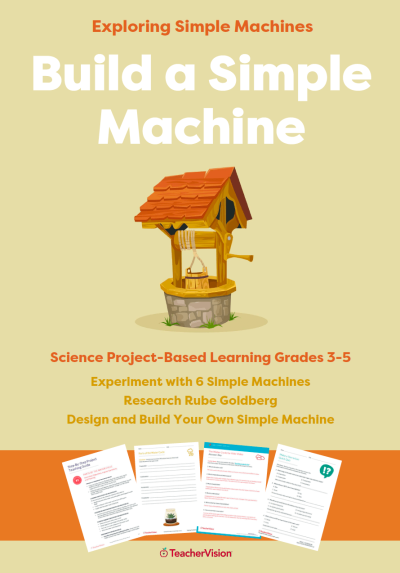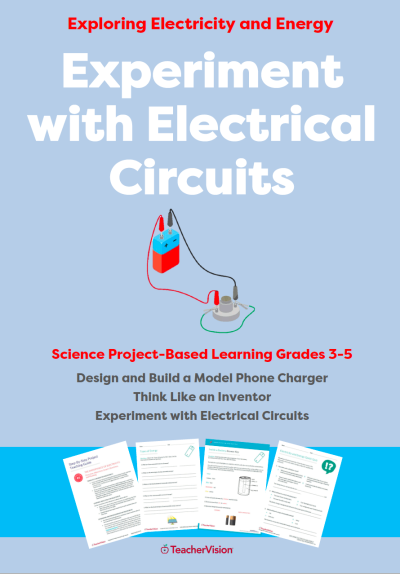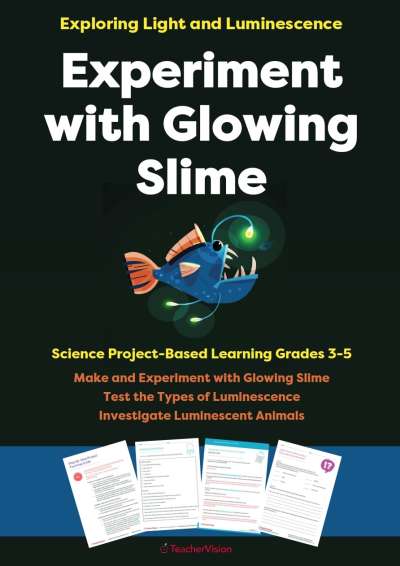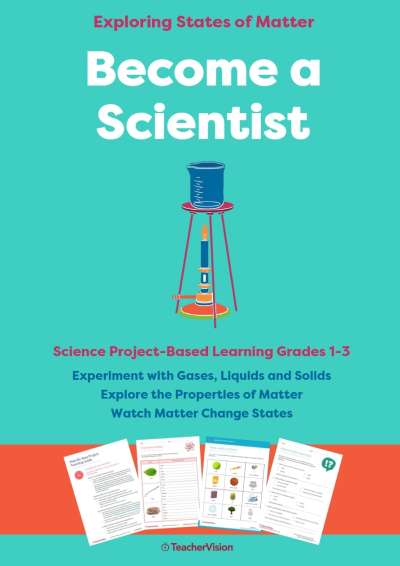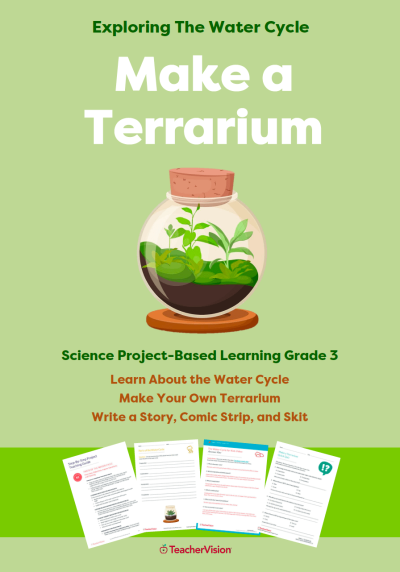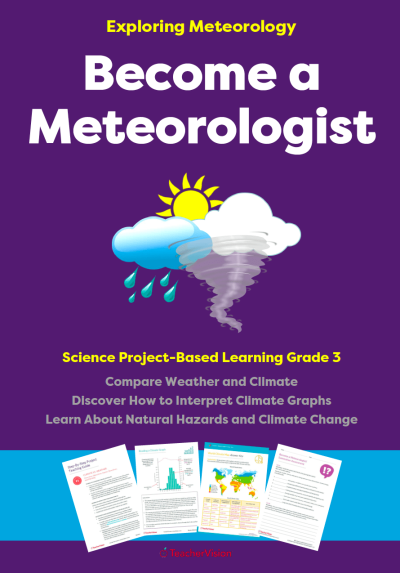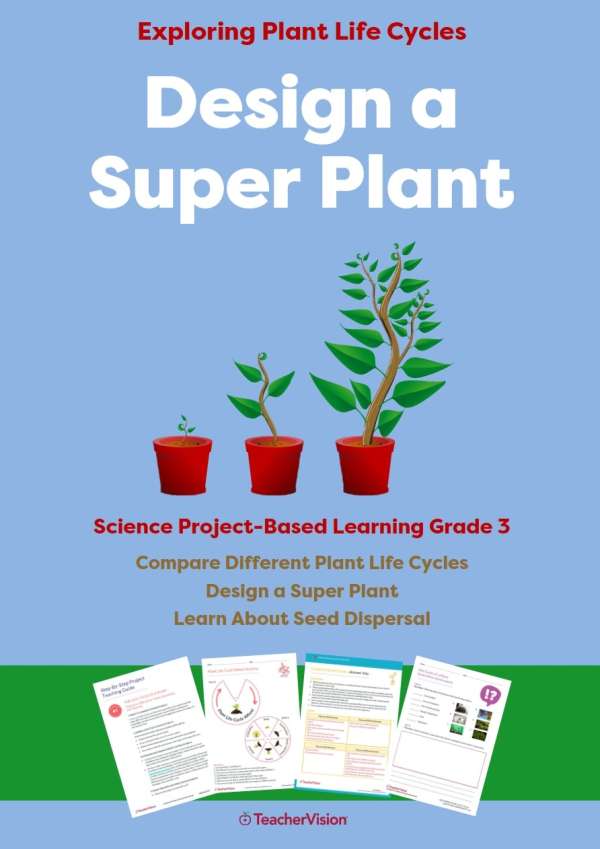
Included with a Premium Membership
Subscribe for instant access to this and every resource on TeacherVision.
NGSS-Aligned Unit on the Life Cycles of Flowering Plants for Grade 3 Science
Build knowledge and understanding of the life cycles of plants, design dispersion models, research and explain plant adaptations, and build a "super plant" that can survive anywhere.
Introduce your 3rd grade science students to the plant lifecycle with this engaging and hands-on project-based learning unit. Students will learn all about the life cycles of plants, perform research and presentations on plant adaptations, design a dispersion model, and "show what they know" by designing and creating a "super plant" that can survive anywhere.
What’s Inside
Packed with fun, hands-on activities, extension and enhancement ideas, opportunities for independent and group work, and engaging inquiry-based challenges, this 56-page project-based unit comes complete with:
- For the Teacher: Engaging social studies lessons with teacher notes, step-by-step instructions for all activities, assessment guidance, and inquiry questions.
- For Students: A full-color Student Pack complete with all of the printables, slides, photos, and instructions students need for the activities - just print (or share) and teach!
A complete, ready-to-teach Teacher Pack that includes:
- Teacher versions of all the student printables with step-by-step annotations and notes for teaching plant lifecycles;
- Formative and summative assessments, answer keys, and a full project rubric;
- Instructions and guidance for the extension activities and project enhancements;
- Materials and resources lists, links to articles, videos, and research, plus additional resources for lecture and presentation.
What's Included
- Lesson Plan - Step-by-Step Project Teaching Guide
- Milestone 1: The Life Cycle of a Plant
- Milestone 2: Compare and Contrast
- Milestone 3: Where in the World?
- Milestone 4: Survival of the Fittest
- Milestone 5: Super Plants
Teacher and Student Resources
- Materials Needed for the Projects in this Unit
- Resources About Plants
- Bellringer Questions and Answer Key
- Plant Life Cycle Wheel Activity
- Teacher Notes for Wheel Activity
- Milestone #1 Inquiry Question
- Comparing Life Cycles: Two Flowering Plants Activity
- Comparing Flowering and Non-flowering Plant Life Cycles Activity
- Comparing Life Cycles Answer Key
- Plant Life Cycle Cards
- Sample Revision for Card Holder Activity
- Milestone #2 Inquiry Question
- Seed Dispersal Design Sheet
- Sample Seed Dispersal Design Rubric
- Sample Seed Dispersal Anchor Chart
- Milestone #3 Inquiry Question
- Tips for Safe Online Research
- How to Research Effectively
- Plant Adaptations Activity
- Sample Answers for Plant Adaptations Activity
- Milestone #4 Inquiry Question
- Plant Adaptations Quick Quiz and Answer Key
- Life Cycle of a Plant Summative Assessment and Answer Key
- Super Plant Design Sheet
- Super Plant Summary Sheet
- Milestone #5 Inquiry Question
- Tips for Creating a Rubric
- Super Plant Design Rubric
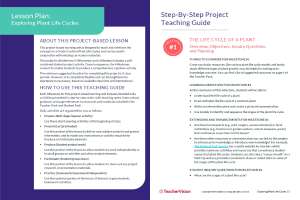
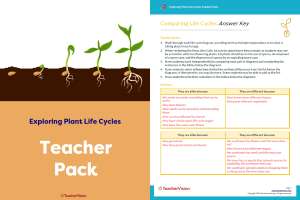
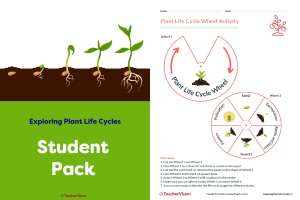
OVERVIEW:
This project-based learning lesson is designed to support and reinforce the concepts in a Grade 3 science unit on the lifecycles of lowering and non-flowering plants. It is built around 5 inquiry-based milestones that incorporate cross-curricular hands-on projects, formative and summative assessments, independent and group activities, and extensions.
STUDENT/GROUP OUTPUT:
In the course of this project-based learning unit, students will:
Build background knowledge about the life cycles of flowering and non-flowering plants;
Create a model for seed dispersal;
Identify characteristics of plant adaptations;
Tie their learning together by designing a "super plant."
SUGGESTED SUBJECT PREREQUISITES:
Students will acquire necessary background knowledge of plant life cycles as part of this project, and instructional materials for providing that background are included in the Teacher Pack.
SEQUENCE AND PACING:
This project-based unit is divided into 5 milestones. The minimum suggested duration for completing this project-based unit is 5 class periods. However, the unit is completely flexible and can be lengthened or shortened as necessary or desired, based on available class time and interest level.
TECHNOLOGY RESOURCES (suggested):
Internet access
STANDARDS ALIGNMENT
MILESTONE #1
• 3-LS1-1 From Molecules to Organisms: Structures and Processes
• Understand the life cycle of a plant.
MILESTONE #2
• 3-LS1-1 From Molecules to Organisms: Structures and Processes
• Develop an understanding of the similarities and differences of plants’ life cycles.
MILESTONE #3
• 3- LS3-2 Heredity: Inheritance and Variation of Traits
• Understand how the environment can affect the traits that a plant develops.
• 3-5-ETS1-3 Engineering Design
• Plan and carry out fair tests in which variables are controlled and failure points are considered to identify aspects of a seed dispersion model that can be improved.
MILESTONE #4
• 3-LS3-1 Heredity: Inheritance and Variation of Traits
• Understand how plants vary in their traits.
• 3-LS4-3 Biological Evolution: Unity and Diversity
• Understand that in a particular habitat some organisms can survive well, some can survive less well, and some cannot survive at all.
MILESTONE #5
• 3-LS4-2 Biological Evolution: Unity and Diversity
• Explain how the variations in characteristics among plants may provide advantages in surviving and reproducing.


